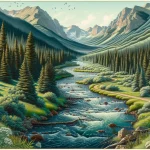Designated as an official Colorado Scenic and Historic Byway in 1994, the route follows the path of early fur traders and trappers, connecting the modern-day cities of Pueblo and Westcliffe. Along the way, travelers pass through diverse landscapes, quaint towns, and sites that bring Colorado’s frontier era to life. From outdoor adventures to cultural attractions, Frontier Pathways has something for every type of traveler. This article explores the top sites and experiences defining this one-of-a-kind byway.
In This Article
TL;DR
- Frontier Pathways is a 103-mile scenic drive through south-central Colorado's Wet Mountain Valley.
- The byway follows the path of fur traders and trappers from the 1800s
- Key highlights include diverse landscapes, historical sites, recreational activities, wildlife viewing, and small mountain towns
Diverse Natural Landscapes
As a journey through Colorado’s foothills, Frontier Pathways treats visitors to a non-stop parade of awe-inspiring vistas. The route winds its way through mountains, canyons, valleys, and plateaus, each with its own unique scenery and personality. As the road starts its climb towards Westcliffe, the landscape transforms into the high-altitude terrain of the San Isabel National Forest. Here, evergreen forests and wildflower meadows blanket the rolling hills, leading to rocky peaks piercing the skyline. For outdoor enthusiasts, this segment of Frontier Pathways provides endless hiking, camping, fishing, and wildlife viewing opportunities.
Further along, the byway descends into the Hardscrabble Canyon area, where eroded badlands and sandstone cliffs create an almost alien visage. Visitors who brave the gravel roads to the remote Spanish Peaks Wilderness are treated to volcanic dikes and an extinct volcano crater that hasn’t erupted in over 100,000 years. Frontier Pathways traverses some of Colorado’s most diverse and magnificent scenery, from mountain vistas to desert plains.
Historical Sites and Landmarks
Beyond just a scenic drive, Frontier Pathways brings Colorado’s frontier history to life through its many well-preserved historical buildings, landmarks, and ghost towns. As the route follows early trading paths, modern-day travelers can glimpse what life was like for intrepid pioneers centuries ago.
One highlight is the town of Colorado City, established in 1858 during the Pikes Peak Gold Rush era. The town has retained much of its 19th-century charm and frontier architecture, with false-fronted buildings lining its main street. Just outside of Colorado City lies Hardscrabble Pass, once a major thoroughfare connecting the San Luis Valley to the booming mining settlements around Pikes Peak. Visitors can still see the wagon ruts etched into the landscape from pioneer wagons.
Other historical attractions include the century-old Greenhorn Valley Schoolhouse, the remnants of abandoned mining towns like Rosita, and Bishop Castle – an elaborate complex of stone towers and buildings hand-built by one man over 50 years. For history buffs, Frontier Pathways offers the perfect blend of scenic backdrops and windows into Colorado’s storied past.
Small Mountain Towns
Beyond the historical sites, one of Frontier Pathway’s biggest draws is its string of charming small towns that look nearly identical to how they did over a century ago. From Westcliffe to Silver Cliff, the byway takes travelers back in time to an era of corner diners, mom-and-pop shops, and laid-back mountain living.
The largest town is Westcliffe, a ranching community in the shadow of the mighty Sangre de Cristo Mountains. Main Street is lined with locally owned boutiques, restaurants serving stick-to-your-ribs fare, and cozy watering holes perfect for swapping stories with fellow travelers. Westcliffe also serves as the gateway to some of Colorado’s most spectacular hiking, camping, fishing, and outdoor recreation.
Further north, Silver Cliff harkens back to Colorado’s prospecting days with its weathered buildings left over from past silver booms. And Rye, located right along Frontier Pathways, offers visitors a compact downtown filled with antique shops and low-key eateries housed inside historic structures. For a taste of authentic small-town Colorado charm, Frontier Pathways delivers.
Outdoor Recreation
While the historical sites and mountain towns are impressive on their own, Frontier Pathways also serves as the gateway to some of Colorado’s most spectacular outdoor recreation. The byway borders several state parks and wilderness areas that offer limitless opportunities for camping, hiking, mountain biking, fishing – essentially any activity imaginable.
One natural area not to miss is the Spanish Peaks Wilderness, located just a few miles off the byway. Comprised of unusual rock formations and the remnants of an ancient volcano, the nearly 20,000-acre reserve has over 100 miles of multi-use trails perfect for backpacking, horseback riding, hunting, and foraging for wild berries.
Closer to Westcliffe, Lake Isabel, and Bishop Castle, allow visitors to enjoy the beautiful Wet Mountain Valley from the water or high up in the air. Lake Isabel offers prime fishing, paddling, and peaceful shoreline camping. Meanwhile, Bishop Castle is an elaborate complex of towers and walkways built from local stone. Visitors can tour the castle and climb to the highest lookouts for panoramic views of the entire region.
With so many parks, trails, peaks, and bodies of water surrounding it, Frontier Pathways gives road-trippers endless opportunities to experience Colorado’s incomparable natural playground.
Local Arts, Culture and Events
Beyond the outdoor attractions, Frontier Pathways visitors can also experience the region’s lively arts scene, cultural traditions, and beloved annual events. The byway also provides front-row access to the area’s agricultural roots and cowboy culture. Several working cattle ranches offer tours where visitors can witness firsthand traditions like cattle drives and rodeo events.
The Greenhorn Valley, located halfway along Frontier Pathways, comes alive each fall during potato harvest season. Travelers in the area from September to October can observe the harvest, learn about innovative water conservation efforts, and sample delicious local spuds.
Finally, one sight not to miss is the golden aspen trees blanketing the Sangre de Cristo mountains each fall. From late September through early October, the hillsides explode into a sea of vibrant yellows, oranges, and reds, creating a spectacular backdrop all along the byway. Visitors planning trips during the fall foliage season may also be lucky enough to experience mountain towns’ harvest festivals or see elk rutting season in full swing.
Scenic Overlooks and Drives
Considering Frontier Pathways winds through some of Colorado’s most dramatic landscapes, the byway offers countless scenic overlooks and offshoot drives perfect for photography or simply relaxing behind the wheel. Travelers armed with cameras will want to stop at the Sangre de Cristo Overlook just a few miles outside Westcliffe. This roadside turnoff treats motorists to panoramic views of the entire Sangre de Cristo mountain range, including several 14,000-foot peaks. Golden aspen trees in the fall provide an extra spectacular sight.
Another must-see attraction for photography enthusiasts is Bishop Castle. Located just 20 minutes off the byway, this hand-built complex of towers and walkways allows visitors to glimpse the Wet Mountain Valley and Sangre de Cristos from unique angles. Sunrise and sunset here should not be missed.
For those looking to venture off the main byway for a spell, two scenic drives branch off Frontier Pathways for even more mountain eye candy. The Silver Thread Scenic Byway, beginning in South Fork, winds through groves of aspens and evergreen forests on its way to Creede and Lake City. Meanwhile, the Collegiate Peaks Scenic Byway between Salida and Buena Vista serves up some of Colorado’s most breathtaking high-altitude vistas. With so many stunning overlooks and side excursions, Frontier Pathways cements itself as one of America’s preeminent scenic drives.
Wildlife Viewing
One final highlight for Frontier Pathways visitors is the abundance of wildlife viewing opportunities available across the region. Because the byway borders several protected mountain habitats, multiple state parks, and vast swaths of national forest, sightings of deer, elk, black bears, bobcats, and even the occasional mountain lion are not uncommon.
Some of the best places to spot animals are in the San Isabel National Forest and Wet Mountain Valley. An extensive trail system provides excellent access during September’s rutting season for spotting grazing elk, mule deer, and impressive bull elk. Early morning and dusk are prime times for wildlife activity.
Birdwatchers also flock to Frontier Pathways, thanks to its diversity of habitats. Riparian areas attract species like Belted Kingfishers and American Dippers, while grassland songbirds like Horned Larks forage in the valleys. Over 200 species have been recorded in the region for avid birders hoping to grow their life lists. With such an abundance of wildlife coexisting beside the byway, visitors should always keep their eyes peeled. They never know what furry, feathered, or even antlered friend they might spot.
FAQ
What is the best time of year to visit Frontier Pathways?
The fall is arguably the best time, thanks to mild weather, fall foliage, and wildlife viewing opportunities. September and October bring golden aspens, festivals, and elk rutting season.
What towns offer the most historical attractions along the byway?
Westcliffe, Silver Cliff, and Colorado City have well-preserved downtowns with frontier-era buildings. Rye also has antique shops and eateries housed inside historic hotels and saloons.
Where is the best hiking and camping along Frontier Pathways?
The San Isabel National Forest and Spanish Peaks Wilderness offer hundreds of miles of hiking trails and abundant campsites perfect for either RV or tent camping.
What stretch of Frontier Pathways has the most scenic overlooks?
The segment between Westcliffe and Silver Cliff offers nonstop postcard-worthy views of the Sangre de Cristo Mountains, especially during the fall foliage season.
What wildlife is common to see in the region?
Elk, mule deer, black bear, and bighorn sheep are frequently spotted in the mountains surrounding Frontier Pathways. Over 200 bird species also inhabit the area.
Are there any family-friendly attractions along the byway?
Bishop Castle is a giant complex of towers and tunnels built from local stone that kids and adults love to explore. Lake Isabel offers calm waters perfect for families to boat and fish.






